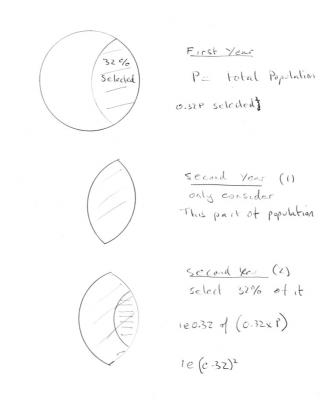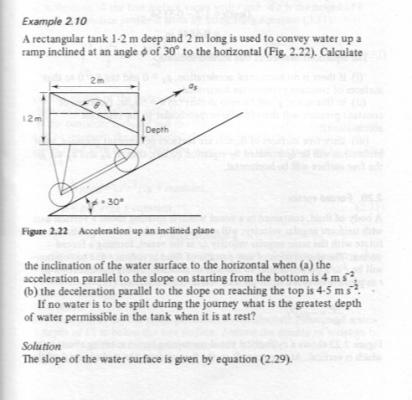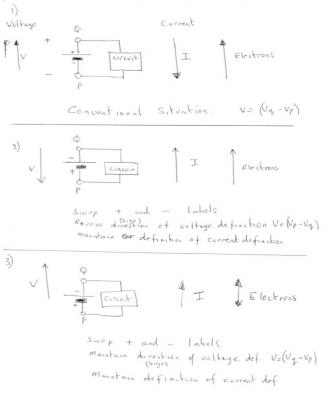-
Posts
18485 -
Joined
-
Last visited
-
Days Won
108
Content Type
Profiles
Forums
Events
Everything posted by studiot
-
You asked in your previous question if you can reduce the number of equations. This problem is the ideal situation for this, you do not need L = 2W, You can simply use 2W, whereever you have written L. So original area= A = W (2W) = 2W2 Can you now write the second equation so that (A - 30) = ??
-
Consider the selection of one single juror. Because there are two probability dependent 'trials or experiments' (the correct statistical words for selection) to consider. One for each year. The combined effect of probability in both trials has to be taken into account. Here is a sequence using Venn diagrams to show why the probability is the product of the individual probabilities. Start with the first year and select 32%. (Fig1) Say the population is 100 so 32 citizens are selected. The only jurors who can be selected both years will come from this 32%. (Fig2) So in the second year select 32% of these 32 (Fig3) ie 10 citizens. Now 32% of something is an old fashioned way of saying multiply by 0.32. So 32% of (32%) = (0.32 x 0.32) = 0.1024. Note that the 68 citizens who were not selected in the first year also have a 32% probability of being selected in the second year So by the same reasoning 0.32 x 68 = 22 citizens were not selected in the first year but selected in the second. Note that 10 + 22 = 32. That is the probability of being slected in the second year is 32% as expected.
-
Millivolts sounds right. Think of a solar panel or Hall effect generator.or even a humble accumulator. They achieve higher voltages by series connection od multiple unts.
-
Perhaps swansont has some more up to date data?
-
V is in metres per second L is in metres E is in volts B is in Tesla or webers per square metre Then everything is in rationalised MKS units (ISO metric). Note also that your formula uses the vector cross product VxB, since both B and V are vectors. This would normally also have a cosine of the angle between them, but since this is 90 cos(90) = 1.
-
See my reply in this thread http://www.scienceforums.net/topic/86021-lunar-azimuth/
-
No azimuth is a property of both the moon's position and the position of the observer. It is not a property of either the observer or the object alone but a combiantion of the two. It is the angle between the position of something and true North, or if you had aligned your theodolite telescope to true North it is the angle you would have to swing through to point at the object. I note you have another thread about Field Astronomy terms but I will try to answer them here. There are two axis passing through the earthly and celestial spheres. One is the axis ot rotation and it passes from North pole to South Pole, through the centre of the Earth and Celestial sphere, which have the same centre and NS axis. The other is a plumb line from the observer on the Earth's surface to the centre of the earth. If this line is extended to the celestial sphere it meets that sphere in the Zenith and Nadir So the zenith and nadir are properties of the observer alone, they are not properties of the observed object. A plane throught he centre of the earth at right angles to this axis is the horizontal plae for the observer. A theodolite measures the angle from this horizontal plane to the object in the sky ie on the celestial sphre as the altitude. The terms you were seeking for the elliptical path taken by objects on the celestial sphere are upper and lower transit or culmination for the highest and lowest altitudes. The left and right ends of the ellipse are called elongation. We can find some pictures if you wish.
-

Is a mathematical zero impossible?
studiot replied to O'Nero Samuel's topic in Linear Algebra and Group Theory
It is curious that one way to construct a number system starts with nothing and generates a set with repeated copies as members to generate the natural numbers in the process. Another interesting observation on the empty set is that 'nothing' distinguishes the two basic objects in geometrical topology (of 3D), the sphere and the torus. The 'hole' is made of 'nothing', but unless it exists the object is a sphere, not a torus So mathematics is founded at least in part, on nothing at all! -
Yes of course the Earth's rotation is slowing, measurably but slowly and the interaction betwen the orbiting moom and the Earth is in a large part responsible. But the fact remains that the water belongs to the Earth and rotates with it. Extracting tidal energy will not change this. I do not have verifiable information about the history of water bodies on the Earth or the Moon on a geological timescale so cannot comment on your other idea.
-
I can't see that it would make any difference to the rotation of the Earth since the energy of the tides has already been transferred to the water on Earth so diverting that energy somewhere else would not loose it to the planet. The fundamental rotation of the planet does not stem from the Earth - Moon interaction. BTW I hope you realise that the term tidal current refers to the horizontal movement of the water and the term tide refers to the vertical? Both motions can be utilised as an energy source, but only some of the energy of motion cna be extracted since the water must still move to extract the energy.
-

Why I'm fired from a Pharmaceutical Company and what can I do...?
studiot replied to chemicalman's topic in Chemistry
Did you never make mistakes in your college course? Well learn from them. So what would you do differently next time? And why only pharmaceutical companies? There is a vast range of anlaytical posts needed out there from water quality to wine or beer or cheese or youghurt.or cement production. this list goes on and on. So buck yourself up, smile and apply somewhere else, you have a (potential) skill that is in demand in most if not all industries. -
Look at section 3.2.1 (Mechanics) of the current (2014 and beyond) A level syllabus for Physics in the UK http://filestore.aqa.org.uk/subjects/specifications/alevel/AQA-2450-W-SP-14.PDF It would seem the UK education authorities disagree with you. and here is the Further Mathematics syllabus (applied mathematics section) http://filestore.aqa.org.uk/subjects/specifications/alevel/AQA-6360-W-SP-14.PDF Once again torque is not discussed under rotational statics or dynamics. So UK educational specifications are in step with each other. Just as a matter of interest I have seen a number of modern textbooks draw a single curved arrow around an axis to denote turning moments of some sort. Ask yourself what would happen if this was actually applied in the fashion indicated to a real physical object? However I could not find any UK textbooks, serving the above syllabus, mentioning torque or offering such a description.
- 64 replies
-
-1
-
I am trying not to cross post with elfmotat, who I think is doing a grand job, but I would just like to reinforce one comment. You need to distinguish between potential and potential difference. This is a common confusion.
-
I am guessing that this is the movement of a charge q along a line L from A to B in an electricfield E. In that case this would be an energy balance saying that the work done intergral (E.dl) equals the potential energy gained. Did you miss out a dot in the first integral?
-
Difficult to offer more specific advice, without more specific information. Like what laptop is it and how do you know only the screen is cracked - what are its symptoms?
-
Indeed so. It's a question of obtaining the correct part.
-
Changing a broken screen is not difficult and takes about 20 minutes. Depending upon the laptop a new screen can cost from £30 to £90, although the laptop manufacturer would probably charge between £150 and £250. You said it was an old laptop and screens for many old laptops are no longer available, though some suppliers supply modern substitutes. You can also find laptops of similar models that are broken for some other reason eg failed motherboard very cheaply and do a transplant that way. You will need a few of the correct tools and some care in handling the parts however.
-
Thank you for all this information to digest. I am still interested in the engineering mechanics of things, and you have not answered my question about impulsive forces, or water levelling. Here is a question from a modern textbook on fluid mechanics, that might be of interest. It is about hauling 'buckets' of water up inclined planes.
-
I suggest you look at posts 20 and 21 for definitions of terminology. I think this thread is not the place to discuss Us v Uk terminology, although I would be happy to in a new thread set up for that purpose. Unfortunately your comments on the screwdriverd are unsound. ( as a matter of interest the most recent US authority on the subject, Sokolnikoff, late professor of mathematics UCLA uses the term couple when describing this situation, p107 of his book) With the screwdriver located into the screwhead, the screwdriver itself is subject to torsion when a couple is applied to the handle, whether the screw moves or not. The difference is that if the screw moves it is obviously not in equilibrium, whilst moving. Torque and tosion and the relationships between them were defined by engineers for sound engineering reasons to distinguish them from ordinary couples and other turning effects and many engineering relationships and formulae have been developed that just will not work using the looser definition of a torque being a single couple around and axis. An unrestrained 'torque' situation with the unengaged screwdriver cannot work for much the same reason as others have been telling Relative you cannot apply a torque at the centre of rotation.
-
Internal energy is a concept that you will not need until university, but it is really a very simple idea. Internal energy is not another particular form of energy like kinetic energy or potential energy under gravity, which you may have met. It is a sort of energy piggy bank to take account of all possible sorts of energy that a body or bunch of molecules or whatever may have. This includes potential energy, which is probably why fuzzwood said what he said. But it also includes kinetic energy, electric energy, chemical energy and heat energy. So if we heat something up the specific heat energy we input adds to its internal energy. This also applies to latent heat. The branch of science that studies how one form of energy can be exchanged for another is called thermodynamics. So you can imagine the internal energy bank as like your money account where you put dollars in and take euros out.
-
+1 swansont. Bignose's ruler experiment was designed and offered to show relative the exact opposte!
-
No, why would I? You have changed what I said, why? I agreed with the following statement you made. Perhaps it's my eyesight but I cannot see torque mentioned. I would agree, and have stated this, that torque cannot be applied without mass since all physical objects have mass at the classical scale. Let me try one last time. Take a screwdriver in your hand and turn it in free air. Your hand is applying a turning effect to the handle The screwdriver rotates as a whole There is no twist or torsion There is no torque Now insert that screwdriver into a screwhead and turn it. Your hand is applying a turning effect to the handle The screwhead is applying a counter turning effect to the bit There is twist and torsion in the shaft That is the sitution where torque arises If the turning effect is greater than the counterturning effect then the shaft will not be in equilibrium and will spin or rotate. This is the situation where an engine develops torque and cannot occut without all the components being in place.
-

Positive and negative - only words used to convey opposites?
studiot replied to Sorcerer's topic in Classical Physics
In further consideration of my last post consider a battery connected to a circuit as in fig1. Conventional current flows from the positive terminal of the battery (Q) to the negative terminal through the circuit. Electrons flow from the negative terminal (P) to the positive through the circuit. Circuit Voltage is reckoned as shown so that V = (Vq-Vp) and has the sign convention that increasing voltage get more positive. Now reverse the signs on the charge so that electrons are now positive. Note that we cannot physically reverse the battery so Q now becomes the battery negative and P the battery positive, and that electrons still exit the P terminal, regardless of its sign. There are choices of adjusting the other conventions. We can leave everything else the same as in Fig3 But hey, Say we have a 10 volt battery and the circuit is a simple 10 ohm resistor so I is 1 amp, what happens. Well Taking Vp as zero and using our definition V = (Vq-Vp) = ((-10) - (o)) = -10 What minus 10? What happens now? Well that means that we are putting in (-10) * (1) watts to our resistor = negative 10 watts. so the sign convention is now at odds with most thermodynamic conventions that energy in is positive. and what about good old ohms law? Well we have to add a minus sign so that V = -(IR) OK let's abandon this and revers our definition of votlage as in Fig2. Note it is now again opposite to the direction of current. We will now recover positive signs in our power and ohmic calculations. But we have had to change two conventions to achieve this. -
Since I would rather say something positive this is the (only) part of your last post that is correct. The inertia is another name for inertial mass.




